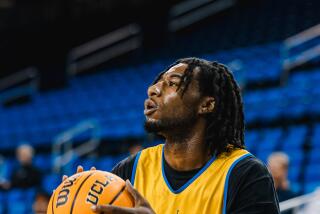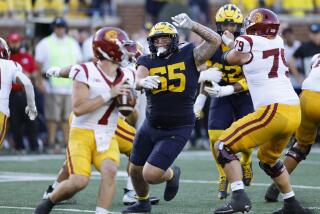One Limp or Two? : Bloodied and Broken, Cal Lutheran Defenders Won’t Be Beaten
- Share via
SAN FRANCISCO — I just lay on the field waiting for someone to help me off.
It hurt, but it didn’t hurt half as bad as it did later--after surgery. The doctor meshed the ligament together and stapled it to the bone at the bottom of the knee. The staple caused constant throbbing. They had me on morphine for three days.
This year, man, I don’t want to go through all that again. I love football, but I want to be able to do other things later in life. Like I want to be able to walk. --Terry Rowe, CLU linebacker
How can this be put tactfully? Last season, Cal Lutheran didn’t play football as much as it walked into a meatpacking plant, had its hide flayed, collarbones, ankles, legs, wrists and elbows broken, rotator cuffs torn, muscles ripped, ligaments wrenched and popped, and its remnants tossed on a hook. What remained lost all six Western Football Conference games and eight of 11 games overall.
“A run of bad luck,” tailback Tracy Downs said.
Bad to the bone.
Hardest hit by the carnage were the linebackers, who spent most of the season lying on their backs. All told, four suffered injuries, among them a ripped calf muscle, nerve damage in the neck, torn knee ligaments and a hip pointer. Another linebacker who made it unscathed through the fall got his comeuppance during spring practices. He broke his leg.
All of this normally would be considered blood under the bridge, the players’ scarified service remembered in Kingsmen annals, their anguish suppressed from memory. But in this case, all five players not only returned for the 1987 season, they were listed as probable starters as linebackers or defensive ends for today’s opener against San Francisco State.
Whether they will respond--or survive--this season remains a mystery, even among themselves. Said Dr. John Tomec, team physician: “We try to encourage them and tell them to overcome. But it’s up to the player. He’s the one who experiences it. He’s the one who has to realize the injured part works.”
Or doesn’t work.
Painful answers already have come to Sean Demmon. Truth be told, they’ve been jammed down his throat. Between brief moments of glory, the 6-0, 220-pound senior has suffered many moments of gore.
During a game against Cal State Northridge in his sophomore season in 1985. “I was making a tackle,” he said. “My right arm was extended and someone fell on my wrist. It snapped.”
It also ended his season. He spent nine months in a cast from hand to collarbone, with the arm incapacitated until the following summer. At the five-month mark, Demmon shed the cast long enough to have surgery--a bone graft from his right hip was applied to the wrist.
Last season, first quarter of seventh game against Cal State Sacramento. “I stepped up to hit their tailback. I felt a burner run up my neck--a real sharp pain. I collapsed on my back. My neck was sore and my arms were limp. I knew right then my season was over.”
The diagnosis was stretched brachial flexures on the left side of the neck. In English: nerve damage. Two months after the injury, Demmon couldn’t extend his left arm. He eventually began a weightlifting program and by the opening of fall drills two weeks ago was set to play defensive end. Even after two-a-day practices began, Demmon said, “I wonder about it sometimes. Coming off this, I’m not sure if I could take a full blow to the head.”
He won’t have to worry about it for another year. During a scrimmage early last week, Demmon’s knee blew out when a teammate landed on it. “I could feel the knee come apart,” he said.
Tomec put it back together this week, performing surgery to repair a torn medial collateral ligament. Demmon will redshirt and try again next season. “I’m grabbing for anything positive,” he said. “It’s tough, but if those other guys can do it, so can I.”
Those other guys are Terry Rowe and Earl Bentancourt, Cal Lutheran’s starting outside linebacker and defensive end, neither of whom could walk at varying junctures last season.
Rowe, who came to Thousand Oaks a year ago from Glendale College in Arizona, was CLU’s best defensive player through three games. He was named defensive player of the week by the National Assn. of Intercollegiate Athletics after his first game. He recorded 10 tackles, forced a fumble and intercepted a pass, going 64 yards for a touchdown.
Rowe was really gone three weeks later.
During a game at Cal Poly San Luis Obispo, he ripped a knee ligament.
“A guy just rammed into my knee with his helmet,” Rowe said. “I had a knee brace on but it didn’t do much good. The medial collateral tore in the middle and the ligament ripped off the bone at the bottom of my knee. I heard a pop. I felt it snap like a rubber band breaking. And I remember a sharp pain inside my kneecap.”
He was in a Phoenix hospital a few days later, undergoing surgery and wondering whether to stay in school. He came back to Cal Lutheran but didn’t make a decision about playing football until July. During rehabilitation, Rowe developed problems with his hamstring and tendinitis in the back of his knee, but has since recovered adequately.
“He’s still a dynamic player,” Coach Bob Shoup said. “He’s playing as well as he was last year.” Rowe has lost some speed. He ran a 4.7 40-yard dash (before surgery) and now runs 4.85. Shoup said the 6-0, 205-pound senior will play an important role in CLU’s new speed-oriented 4-3 defense. “He’s fast enough,” the coach said, grabbing for the positive.
Bentancourt’s story is perhaps the most grisly.
In 1985, he suffered what amounted to a ligament meltdown in his right knee. Said Dr. Jerome Friedland, who was called on to clean up the mess: “He tore up the whole thing, all the ligaments. That’s about as bad as it can get. It’s amazing that he can run again.”
Friedland operated on Bentancourt for five hours. He took a piece of hamstring tendon and put it in the knee. He filed down the knee bone, cut damaged cartilage and stapled the major ligaments in place.
Painful?
“They had to tie me down in the recovery room,” Bentancourt said, “because I hit one of the nurses.”
He was still a linebacker at heart.
The knee was in a cast for four months. A second operation was performed two months later to remove scar tissue and a staple that had been causing excessive pain. Bentancourt’s rehabilitation primarily consisted of stretching and lifting weights and, to everyone’s surprise, he thought he was ready to play again near the start of last season.
The miracle dissolved two weeks before fall practices when Bentancourt tore his calf muscle in the same leg while running sprints. Doctors told him the muscle would take two months to heal. “I thought, ‘What’s going on?’, “ he said. “I was thinking maybe it wasn’t meant to be. Maybe it was a sign from God that I shouldn’t play. After all that work, it was the most depressing time of my life.”
He could have chucked football and graduated in May, but he wanted one more chance. So far in 1987, he’s still alive. “He’s been really sore,” Shoup said. “After practice, he looks like a Neanderthal man that they pulled out of an ice pack.
“But he’s earned back a starting spot.”
And near-legendary status among his teammates as the Thing That Wouldn’t Die. “I think he hurts every single day he’s out here,” said Tom Gabriel, another of the play-and-pray linebackers.
Gabriel broke his left leg when he tripped during a “bag drill” in March. Other than “a little stiffness,” Gabriel said he’s completely recovered now, and he downplays the broken fibula. Shoup agrees, saying: “That broken leg is most predictable. The healing process is good and I expect him to be 100%.”
That leaves Torii Lehr, a linebacker whose hip pointer, in relative terms, amounted to a mosquito bite. However, such an injury--damaged tissue above the hip bone--results in extreme pain, the kind you might experience if Nolan Ryan slammed a bowling ball off your hip. In this case, it was an offensive lineman’s helmet.
“It splattered the muscle across the bone,” said Lehr, who missed two games. “Nothing, really, just a lot of pain.”
“He’s got no lingering effects,” Shoup said. “He’s looked great in practice . . . They all have. This is a fine group. They are the strength of our team. They’ve overcome the physical and mental aspects of injuries. They’ve worked hard and gone through a lot. There’s a good feeling there.”
That’s a switch, a good feeling.
“We just want to play,” Lehr said. “We have a bit of paranoia. We still worry about reinjuring the injuries. The thoughts are there. But the guys have talked it over and decided, if it happens, it happens.
“Inside, we’re just praying to the football gods that it won’t.”
More to Read
Go beyond the scoreboard
Get the latest on L.A.'s teams in the daily Sports Report newsletter.
You may occasionally receive promotional content from the Los Angeles Times.










